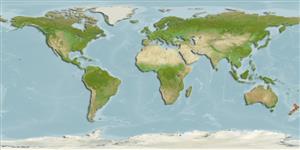Teleostei (teleosts) >
Perciformes/Serranoidei (Groupers) >
Anthiadidae (Fairy basslets or Streamer basses)
Etymology: Hypoplectrodes: Greek, hypo = under + Greek, plektron = sting, spur + Greek, oides = similar (Ref. 45335).
Environment: milieu / climate zone / depth range / distribution range
Ecology
Marine; reef-associated; depth range 0 - 100 m (Ref. 9003). Temperate
Southwest Pacific: endemic to New Zealand. Report from Australia (Ref. 28618) needs to be verified.
Size / Weight / Age
Maturity: Lm ? range ? - ? cm
Max length : 20.0 cm TL male/unsexed; (Ref. 9003)
Solitary fish found in deep holes and rock ledges which rarely strays far from its refuge. Feeds on small fishes, crabs and benthic invertebrates (Ref. 26966).
Life cycle and mating behavior
Maturity | Reproduction | Spawning | Eggs | Fecundity | Larvae
Paulin, C. and C. Roberts, 1992. The rockpool fishes of New Zealand (Te ika aaria o Aotearoa). Museum of New Zealand (Te Papa Tongarewa). 177 p. (Ref. 9003)
IUCN Red List Status (Ref. 130435)
Threat to humans
Harmless
Human uses
More information
Common namesSynonymsMetabolismPredatorsEcotoxicologyReproductionMaturitySpawningSpawning aggregationFecundityEggsEgg development
ReferencesAquacultureAquaculture profileStrainsGeneticsElectrophoresesHeritabilityDiseasesProcessingNutrientsMass conversion
Tools
Special reports
Download XML
Internet sources
Estimates based on models
Phylogenetic diversity index (Ref.
82804): PD
50 = 0.5039 [Uniqueness, from 0.5 = low to 2.0 = high].
Trophic level (Ref.
69278): 4.1 ±0.0 se; based on diet studies.
Resilience (Ref.
120179): High, minimum population doubling time less than 15 months (Preliminary K or Fecundity.).
Fishing Vulnerability (Ref.
59153): Low vulnerability (10 of 100).
Nutrients (Ref.
124155): Calcium = 19.8 [10.2, 45.7] mg/100g; Iron = 0.24 [0.12, 0.49] mg/100g; Protein = 18.6 [16.7, 20.4] %; Omega3 = 0.476 [0.250, 0.907] g/100g; Selenium = 6.67 [2.99, 15.43] μg/100g; VitaminA = 137 [37, 597] μg/100g; Zinc = 0.568 [0.356, 0.878] mg/100g (wet weight);
